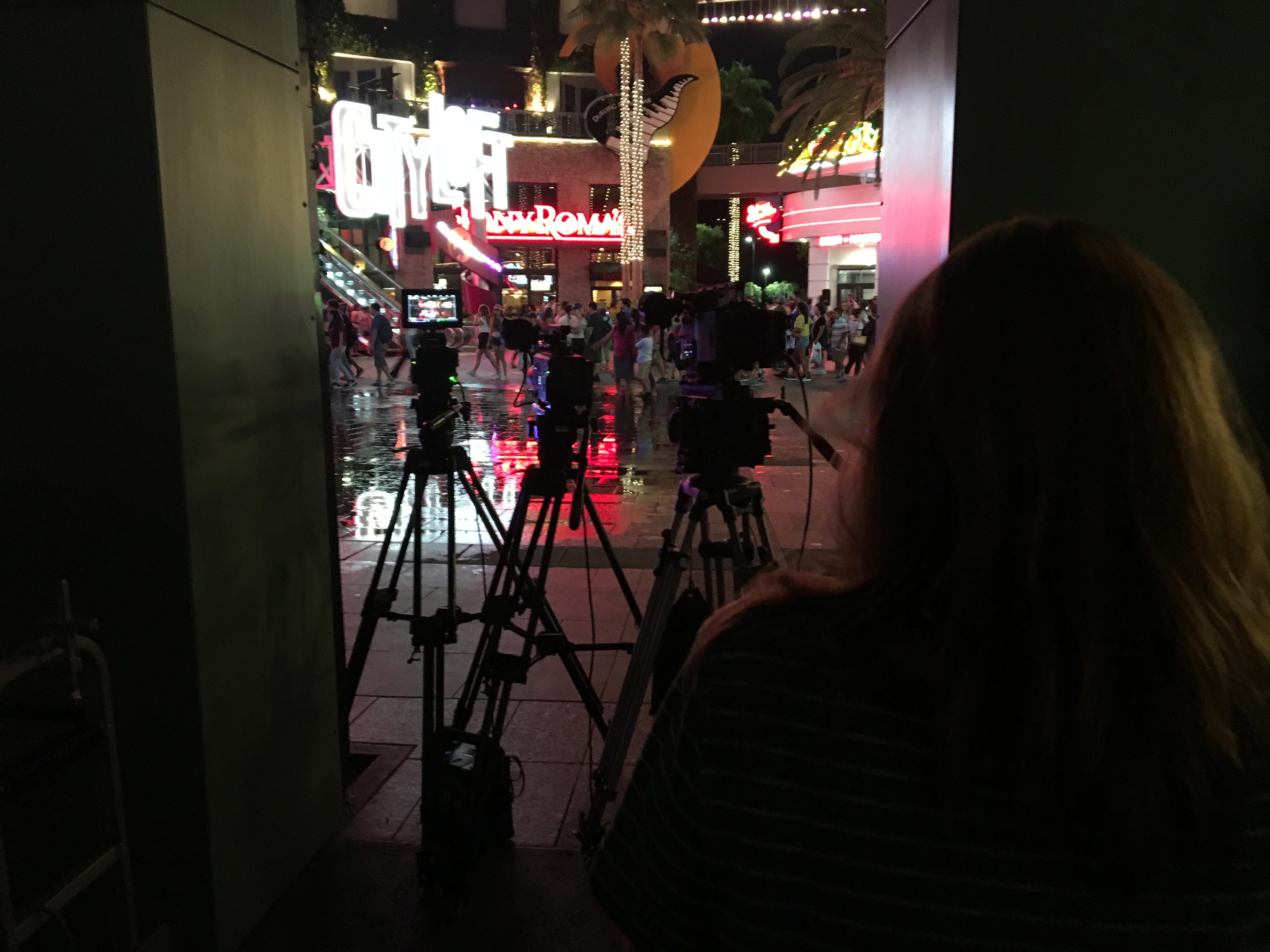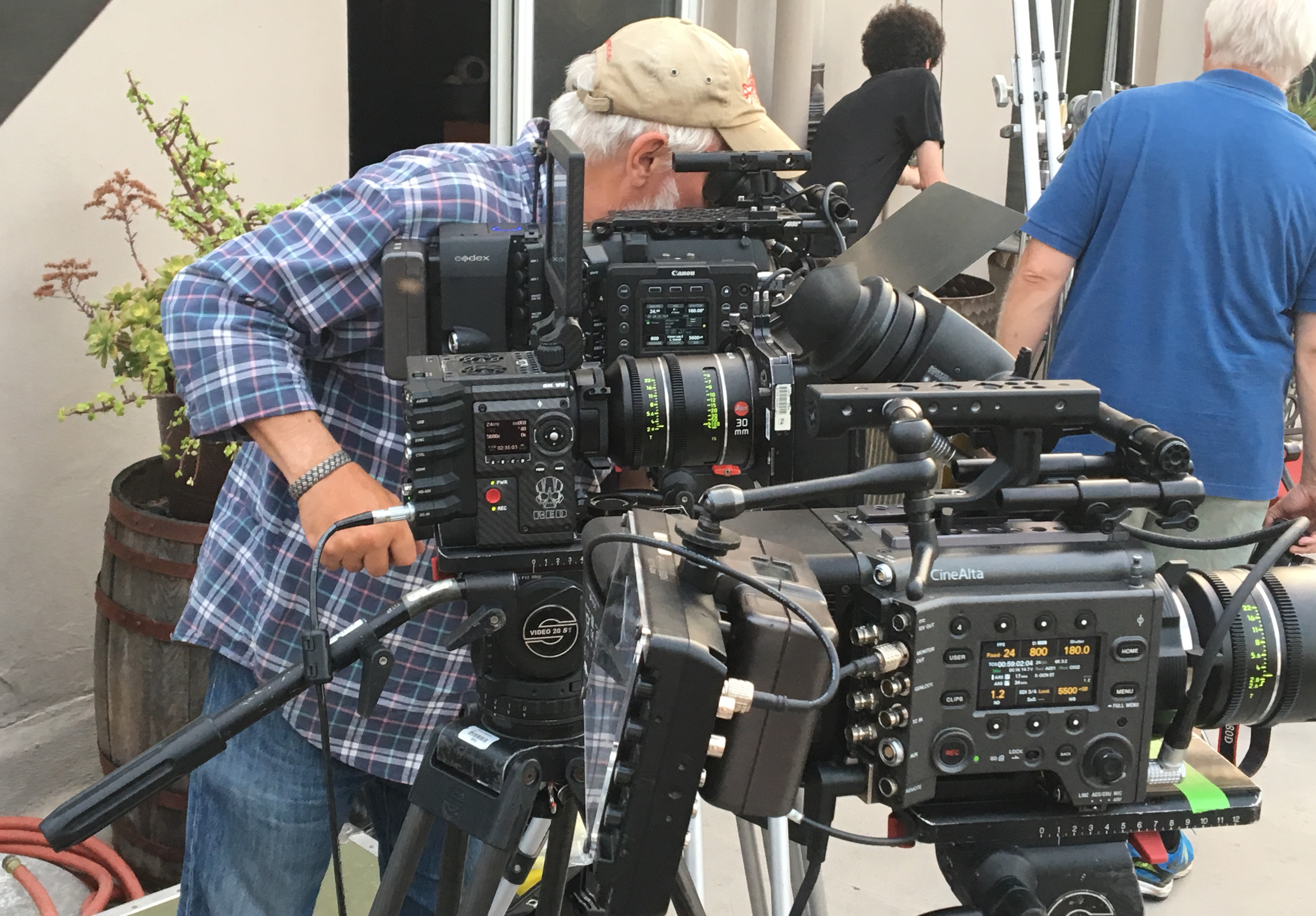
Measuring Up: Testing Digital Cameras for Large-Screen Exhibition Use
James Neihouse, ASC examines an array of 6K+ units for the Giant Screen Cinema Association.
James Neihouse, ASC examines an array of 6K+ units for the Giant Screen Cinema Association.

Large-format cinematography specialist James Neihouse, ASC (Hubble 3D, NASCAR: The IMAX Experience, A Beautiful Planet) was tapped in late July of 2018 by the Giant Screen Cinema Association (GSCA) to helm a series of tests to examine all of the top digital cinema cameras (6K and above). As the testing would take place in Los Angeles, Neihouse asked me to join him on this adventure and the two of us spent four days venturing around LA from sunup to past sundown to put the 6K+ camera to the test.
The test was produced by GSCA executive director Tammy Martin Seldon and Michael Daut, GSAC Technical Committee co-chair and director, new business development of the Los Angeles-based immersive design agency Mousetrappe. The test included the Arri Alexa 65, Canon C700 Full Frame, Panavision DXL-2, Red Weapon Monstro VV and Sony Venice cameras. All tests were shot with the Leica Thalia Full Frame lenses, provided by CW Sonderoptic/Leica.


The test started early in the morning on a Tuesday at the Paramount Ranch facility in Agoura Hills, CA. Neihouse, myself and a number of volunteers set the cameras up on the ranch to catch the hot sunlight coming down a western set main street. The intention was to capture a naturally high-dynamic range shot and push the limits of each camera. Utilizing the harsh, open, California sunshine, we shot various setups with subjects in open shade and hot backgrounds, foliage against bright blue sky, the sun beating against the white clapboard walls of a old-West church, etc. It was a hot August morning as we battled aggressive gnats and oppressive sunlight before moving on to our second location, a downtown Los Angeles elegant loft apartment location with a patio view of the city skyline. Inside the loft we shot a test with people sitting by bright day lit windows, lit only by natural light. The extreme dynamic range of bright sunlight mixed with deep indoor shadows was a strain on all the cameras.

We then moved out to the patio and set up all five cameras simultaneously to shoot the setting sun reflecting off LA high rises. Once night fell, we shot scenes featuring the city lights.
The following day, we started back in downtown, shooting various buildings, activity in Grand Park, the sunrise, and, again, focusing on capturing high-dynamic-range images designed to tax the cameras as much as possible. That evening, we journeyed to nearby Universal CityWalk, where we again shot the setting sun and night activity with a wide range of colored light sources.


Finally, we brought in several models and shot skin tone tests in a controlled environment under tungsten and daylight lighting at the Mousetrappe facility in Glendale. We finished the testing by carefully photographing resolution charts with each camera under strictly controlled conditions.
“One of the mandates of the Giant Screen Cinema Association is to facilitate the production of high-quality educational and entertaining giant screen content,” offers Neihouse. “To support that mandate, the technical committee of the GSCA has conducted various evaluations of equipment and techniques over the past few years. The first was called ‘Bring Back Our Wide Shots’ — or BBOWS — a comparison of what was then the top-of-the-line digital cameras to Imax 15-perf 65mm film in a side-by-side assessment. This current evaluation is a follow-up to BBOWS, using the current crop of high-resolution digital cameras. The material obtained in this round will be screened for the GSCA membership at our annual conference in Chattanooga, Tennessee, in late September and then again in March in Los Angeles. The material will also be available for critical evaluation by members and non-members. The technical committee is not making any judgments on the results, we are leaving it up to the individual filmmakers to choose the camera they feel does the best job.”

After we wrapped shooting, I asked Neihouse some key questions regarding the project:
American Cinematographer: What were some things that you discovered during the test itself?
James Neihouse, ASC: It was very interesting having to deal with five different sensor sizes, we spent a lot of time picking lenses that would give us similar vertical field of views.
Why the choice of Leica lenses?
We wanted the best quality lenses that would cover all the sensor sizes of the cameras, and be in the same “family” of glass. We wanted to take away the variable of having different lenses, even the playing field there, so to speak, so the Leica Thalias were chosen. CW SonderOptic was very helpful there, they provided most of the lenses.
Any surprising results?
We filmed the Walt Disney Concert Hall in downtown Los Angeles, the exterior of the building is a beautiful configuration of highly reflective metal panels. We filmed in the morning as the sun was giving us a very bright highlight off the structure. I was surprised that only two of the cameras could hold that highlight very well, the other three, not so much…
How did you come to choose these particular cameras?
We were looking for sensor resolution higher than 6K. Even though the test was named the “8K Digital Camera Comparison Test,” we had lower-resolution cameras in the mix. The second criteria was the aspect ratio. We wanted to find cameras that could shoot at a high enough resolution to allow for cropping the sides of the image to obtain an aspect ratio of 1.43:1 and not have the resulting image go below 4K in horizontal resolution. We ended up choosing the Arri Alexa 65 because of its large sensor and its track record in the giant screen industry; the Canon C700 Full Frame, while it is the lowest resolution camera we tested, I wanted in the mix because I had such good luck with the C500 on A Beautiful Planet and it records uncompressed raw to Codex drives; Panavision DXL2 and Red Weapon Monstro were picked for their VistaVision-sized sensor, they were the only 8K cameras in the lineup and I am anxious to see the difference between the two since they share a common sensor; the Sony Venice was picked for its sensor size and 1.5:1 aspect ratio, it also has interesting color sensitivity. One camera we didn’t get into the lineup is the Arri Alexa LF, with its 4.5K, 1.44:1 aspect ratio sensor it should be a contender, but we were unable to get one in time for the test. As always, the camera suppliers were very, very helpful in supporting this test, and I really can’t say enough good things about the support we received from Arri, Canon, Panavision, Red and Sony.
How did you come to choose each subject to shoot — what were you looking for?
We were looking to stress the cameras as much as possible, so there were scenes with very high dynamic range and a lot of fine detail. We wanted to shoot long shots with plenty of variation in detail, because that is where the digital cameras fall apart on the giant screen, and why we named the first round of “Bring Back Out Wide Shots.” We also shot some low light scenes to see how well each camera would handle underexposure. We also brought in several models of varying skin coloration to test the skin tone reproduction of the cameras.
Any other thoughts or take-aways?
Some of the cameras were more suited to documentary work than others, mainly in ease of use and ergonomics, that’s something that needs to be considered when shooting with a small crew, under a demanding schedule. In general, I’m very excited about the prospects of these latest digital cameras, if they give us an image that is equal to or better than 65mm 15-perf film, then so much the better. In my opinion, there are still some issues that need to be resolved with digital, and with these high-resolution cameras, data storage is high on the list. Because we are going on to screens that can be as large as 117' x 97' it is necessary to shoot non-compressed or as low compression as possible, and that means a lot of data storage. Securing the data is another matter that needs more attention, it’s just too easy to lose images. In general, I think it is very important to keep the sensibilities of shooting film on a digital show. The practice of just rolling and rolling because you can do that with digital, takes away from the craft and cheapens the process. I’ll always choose to shoot film when I can, and it serves the picture. There’s just something special about the look and “feel” of film, emulsion equals emotion. I’ve always said I would be happy to shoot a movie using a tin can with a pinhole if it served the story, it sure would be a lot lighter than carrying around a 65mm film camera!
The Giant Screen Cinema Association Film Expo and Filmmaker Symposium, where the results of this test can be seen, will be held March 11-13 at the AMC Universal CityWalk 19 Theater. Tickets are available here.
Thanks to Eli DiFore for his invaluable help on this series of tests.







